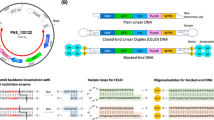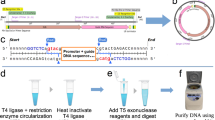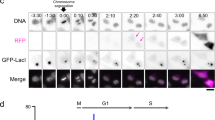Abstract
THE chromosome of bacteriophage ϕ29, one of the smallest Bacillus phages, is a non-permuted linear duplex DNA molecule of molecular weight 11 × 106 (refs 1 and 2) that seems to be circularised by association with a protein, as circular monomers are converted into linear monomers by treatment with proteolytic enzymes3. A similar circular DNA–protein complex has been reported for adenoviruses4. DNA extracted from phage ϕ29 is infectious (transfectious) when added to competent cells of B. subtilis5. This trans-fectivity is sensitive to proteolytic enzymes6, indicating that some protein is associated with ϕ29 DNA and is required for transfection. Protease-sensitive transfection has also been observed with DNAs of B. subtilis. subtilis phages, GA1 (ref. 7), SPO2 and ϕ105 (H. Hirokawa, personal communication).
This is a preview of subscription content, access via your institution
Access options
Subscribe to this journal
Receive 51 print issues and online access
$199.00 per year
only $3.90 per issue
Buy this article
- Purchase on Springer Link
- Instant access to full article PDF
Prices may be subject to local taxes which are calculated during checkout
Similar content being viewed by others
References
Anderson, D. L., Hickman, D. D., and Reilly, B. E., J. Bact., 91, 2081–2089 (1966).
Anderson, D. L., and Mosharrafa, E. T., J. Virol., 2, 1185–1190 (1968).
Ortin, J., Vinuela, E., Salas, M., and Vasquez, C., Nature new Biol., 234, 275–277 (1971).
Robinson, A. J., Younghusband, H. B., and Bellett, A. J. D., Virology, 56, 54–69 (1973).
Reilly, B. E., and Spizizen, J., J. Bact., 89, 782–790 (1965).
Hirokawa, H., Proc. natn. Acad. Sci. U.S.A., 69, 1555–1559 (1972).
Arwert, F., and Venema, G., J. Virol., 13, 584–589 (1974).
Tsien, H. C., et al., Informative Molecules in Biological Systems (edit. by Ledoux, L. G. H.), 431–444 (North Holland, Amsterdam, 1971).
Talavera, A., Jiménez, F., Salas, M., and Vinuela, E., Virology, 46, 586–595 (1971).
Talavera, A., Salas, M., and Vinuela, E., Eur. J. Biochem, 31, 367–371 (1972).
Borst, P., in Autonomy and Biogenesis of Mitochondria and Chloroplasts (edit. by Boardman, N. K. et al.), 260–266 (North Holland, Amsterdam, 1975).
Moreno, F., Camacho, A., Vinuela, E., and Salas, M., Virology, 62, 1–16 (1974).
Brown, N. C., Proc. natn. Acad. Sci. U.S.A., 67, 1454–1461 (1970).
Ivarie, R. D., and Pène, J. J., Virology, 52, 351–362 (1973).
Kornberg, A., DNA Synthesis (Freeman, New York, 1974).
Jazwinski, S. M., Marco, R., and Kornberg, A., Proc. natn. Acad. Sci. U.S.A., 70, 205–209 (1973).
McGuire, J. C., Pène, J. J., and Barrow-Carraway, J., J. Virol., 13, 690–698 (1974).
Author information
Authors and Affiliations
Rights and permissions
About this article
Cite this article
YANOFSKY, S., KAWAMURA, F. & ITO, J. Thermolabile transfecting DNA from temperature-sensitive mutant of phage ϕ29. Nature 259, 60–63 (1976). https://doi.org/10.1038/259060a0
Received:
Accepted:
Issue Date:
DOI: https://doi.org/10.1038/259060a0
This article is cited by
-
An inhibitory effect of RGD peptide on protein, priming reaction of bacteriophages ϕ29 and M2
Molecular and General Genetics MGG (1989)
-
Bacteriophage ϕ29 DNA replication in vitro: Participation of the terminal protein and the gene 2 product in elongation
Molecular and General Genetics MGG (1984)
-
In vitro initiation of bacteriophage Φ29 and M2 DNA replication: Genes required for formation of a complex between the terminal protein and 5′dAMP
Molecular and General Genetics MGG (1983)
-
Transfection of protoplasts of Bacillus subtilis with ϕ29 DNA
Molecular and General Genetics MGG (1981)
-
Physical arrangement of suppressor-sensitive mutations of Bacillus phage M2
Molecular and General Genetics MGG (1981)
Comments
By submitting a comment you agree to abide by our Terms and Community Guidelines. If you find something abusive or that does not comply with our terms or guidelines please flag it as inappropriate.



